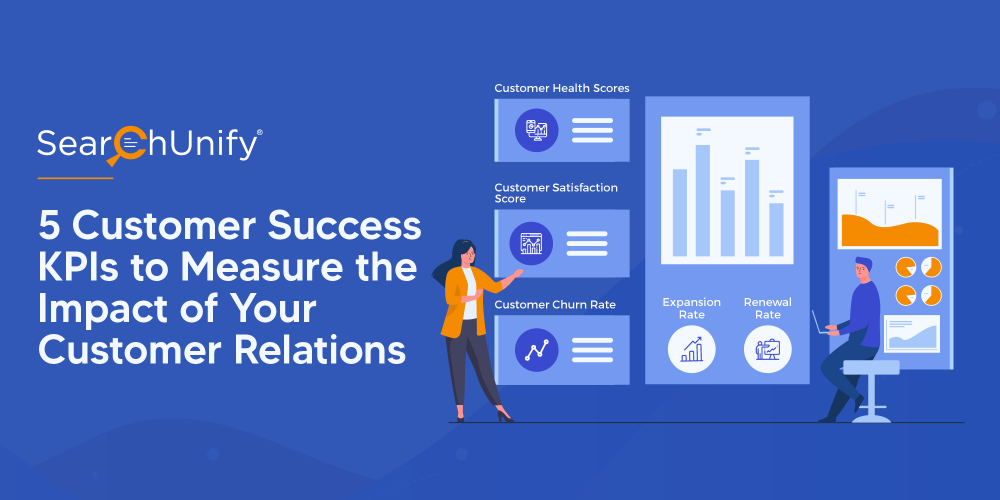
“Customer Success is where 90% of the revenue is.” –Jason M. Lemkin
Growing companies and their founders will tell you that customer success is no longer a buzzword but a proactive and focused approach for creating lifelong customers. That’s because they know that the probability of selling to an existing customer is 60–70%, which is way more than selling to a new prospect i.e., 5-20%. Also, the latter costs five times more!
This is the reason that the concept of having customer success teams has gained widespread attention. It can be directly tied to a company’s customer retention, churn rates, CSAT scores, and therefore the bottom line. Along with explaining what customer success is, this blog post explains the top five KPIs to track regularly to be on top of your game.
What Is Customer Success and How Does It Differ From Customer Support?
Customer support is an army of frontline workers that take care of customer issues and requests over a variety of channels such as email, phone, chat, social media, etc. This is essentially a reactive way of helping customers when they contact you.
Customer success teams, on the other hand, are involved with a customer from the start and throughout their journey to take care of the kinks in between. They proactively suggest ideas to get maximum value from your product(s) & services. Due to this very reason, they closely work with sales, support, product, and even service teams. TSIA, a leading technology & services research organization, says that:
“Customer Success is a service capability with a sales result.”
Now, that we know what customer success is and why it matters, let’s look at its KPIs so that you can measure them regularly and see if you are going the right way.
Measuring Customer Success: Key Performance Indicators
While there is no one-size-fits-all approach to measuring customer success, below are some of the metrics that can be used to measure how successful your program is. You can always add your industry-specific metrics to this list of KPIs.
1. Renewal Rate
As Maya Angelou once said, “People will forget what you said, people will forget what you did, but people will never forget how you made them feel.”
You’re no longer selling a product or service but feelings. How a customer feels about your brand will decide whether or not they renew your subscription. You can calculate the renewal rate with this simple formula:
Renewal Rate (RR) = Number of customers who renewed subscriptions/ Total number of customers who were up for renewal
2. Expansion MRR
Expansion Monthly Recurring Revenue, abbreviated as Expansion MRR, is the additional revenue you generate from your existing customers. What makes it special is the fact that you don’t incur any extra cost to earn it. This way, it also functions as a strong indicator of CSAT and customer loyalty.
Expansion MMR (%) = [(Expansion MRR at the end of month – Expansion MRR at the beginning of month)/Expansion MRR at the beginning of month] x 100
3. Customer Churn Rate
This indicates the rate at which your customers are giving up your product or service and leaving you. If it’s consistently increasing, there are some serious issues you need to identify and fix. But calculating the rate is rather simple:
Churn Rate (CR) = The number of customers lost during the month/The number of customers who are still using the product
4. Customer Satisfaction Score
The most beloved KPI of straight shooters. CSAT surveys like Net Promoter Score (NPS) are plain and simple and ask customers something along the lines of, “How likely are you to recommend our product and services to your friends or colleagues?”

Source : www.netpromoter.com
CSAT surveys can also have questions such as, “How would you rate your overall satisfaction with our product or service?” Based on what they rate on a scale of 0-10, a score is calculated by subtracting promoters from detractors.
5. Customer Health Scores
As a business scales and the customer base grows, calculating this metric becomes imperative. In fact, it includes several factors to predict customer churn and customer expansion with your business.
Because there is no direct formula to measure Customer Health Scores, we created a five-step approach to calculating it. Here is a step-by-step infographic that will help you define and measure customer health scores for your company. It includes several metrics such as overall usage of the product, depth of product usage, number of support tickets raised, etc. You will find all of them in this infographic.
EndNote
The point of measuring all these KPIs is to give your company a clearer picture of what customers feel about your product and service(s) and how can you change it. This will ultimately build your brand reputation in a crowded marketplace and drive customer loyalty.
Want to Elevate Your Customer Success Function? A Unified Cognitive Platform Helps
One of the best ways to ensure your customers’ success is by upping your digital infrastructure. Both agents and customers engage with your digital channels to satisfy their needs. But do they have a pleasant experience?
Can they find what they came looking for? You’ll be surprised at how many times people cannot find the content that exists. That makes better content findability imperative. In this panel discussion, hear how Delphix, a leading intelligent data platform, revised its content strategy to improve content health and deliver a more personalized experience. Tune in right here!


















